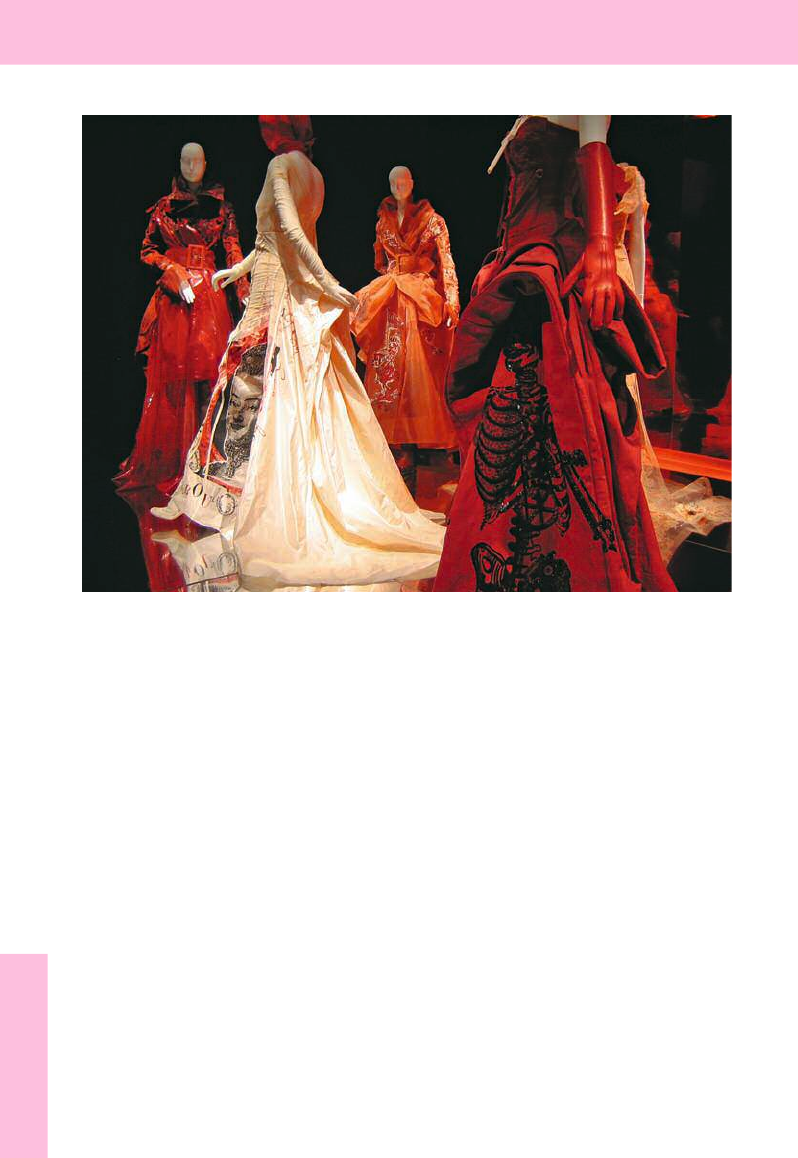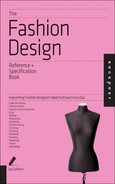
Job:02-30034 Title:RP-Fashion Design Ref and Spec Book
#175 Dtp:225 Page:234
234-241_30034.indd 234 2/27/13 6:29 PM
2 3 4 THE FASHION DESIGN REFERENCE + SPECIFICATION BOOK
(Text)
Chapter 23: Art
The question should not be, Is fashion art? but rather, When is fashion art?
Fashion, after all, is a business in which design is responding to a functional
challenge. Many will argue that fashion’s production of utilitarian items that
are not exclusively an artistic expression—meant to stimulate the beholder’s
thoughts and emotions—disquali es it as an art form. But there are times
when fashion designers take their work to a place that can only be described
as art. Intent is at the core of the issue: What drives the designer? The very
fact that fashion stirs passionate debate around this question is enough to
give it a place at the table. Aesthetic value, it must be also be remembered,
is never universal, but always evolving in what it excludes or includes.
IN THE MUSEUM
Garments
Traditionally, museums have collected fashion drawings and garments (as a textile) only for
their historic value. The benefits of knowing what people wore within the context of when
they wore it slowly gained credibility as a reason for creating fashion archives. These sort of
fashion collections can both chronicle an era and document the lives and accomplishments of
iconic figures. For example, the John F. Kennedy Presidential Library’s 2002 exhibit Jacqueline
Kennedy: The White House Years examined the First Lady’s influence on fashion and style at a
time when the world was watching every move she made and everything she wore.
At the same time, museums have put works traditionally categorized as fine arts into context
by showing the correlations between them and the design arts, including fashion design. For
example, the shift toward Cubism for artists like Pablo Picasso and Georges Braque and their
appreciation for clean lines, fragmented angular planes, and a sense of transparency might be
displayed in the flapper fashions of Coco Chanel, Madeleine Vionnet, and the Callot Soeurs.
Or an exhibit might pair the kinetic canvases of op art painters like Victor Vasarely and Bridget
Riley with the mod designs of Rudi Gernreich and Mary Quant.
Only in recent decades has the work of fashion designers been collected, studied, and dis-
played on its own merit. Museum shows might focus on the artistic contribution of designers
and examine their cultural and sociological impact in the twentieth and twenty-first centuries;
others shows might focus on innovations in garment making. For example, in 1983 the designs
of Issey Miyake, a leader in experimenting with the structure of garments and their relation to
the body, began to travel to art museums around the globe in the exhibition Bodyworks; his
work also appeared on the cover of Artforum, the first time clothes were given space in a ma-
jor art magazine.
Courtesy of James Hill/John F. Kennedy Library and Museum, Boston.
23
Job:02-30034 Title:RP-Fashion Design Ref and Spec Book
#175 Dtp:225 Page:234
234-241_30034.indd 234 2/27/13 6:14 PM

Job:02-30034 Title:RP-Fashion Design Ref and Spec Book
#175 Dtp:225 Page:235
Book
e:234
234-241_30034.indd 235 2/27/13 6:29 PM
2 3 5
(Text)
f
a
r
e
t
s
Celadon silk dress, Oleg Cassini, 1962
Jacqueline Kennedy: The White House Years,
John F. Kennedy Presidential Library and Museum,
2002
Courtesy of James Hill/John F. Kennedy Library and Museum, Boston.
23
Job:02-30034 Title:RP-Fashion Design Ref and Spec Book
#175 Dtp:225 Page:235
Book
e:234
234-241_30034.indd 235 2/27/13 6:14 PM

Job:02-30034 Title:RP-Fashion Design Ref and Spec Book
#175 Dtp:225 Page:236
234-241_30034.indd 236 2/27/13 6:29 PM
2 3 6 THE FASHION DESIGN REFERENCE + SPECIFICATION BOOK
(Text)
A exhibition installed a few years ago at the Museum of Fine Arts in Boston, Massachusetts,
made the case that fashion should be looked at as a fine art. Called Fashion Show: Paris
Collections 2006, it showcased the then-current work of contemporary designers Azzedine
Alaïa, Hussein Chalayan, Karl Lagerfeld for Chanel, John Galliano for Christian Dior, Christian
Lacroix, Maison Martin Margiela, Olivier Theyskens for Rochas, Valentino, Viktor & Rolf, and
Yohji Yamamoto. That the show was put on by a museum of fine arts and not an institution
dedicated to fashion provoked debate, an echo of the grumblings heard in 2000 when the Gug-
genheim Museum in New York gave over its rotunda to a retrospective of the work of
designer Giorgio Armani.
A
T
a
h
n
G
s
in
a
O
lin
La
ti
S
ca
R
se
co
Fashion Show: Paris Collections 2006, Museum of Fine Arts, Boston, 2006–2007
Photograph by Christine Liu.
Au
Photograph courtesy of Judith Leiber.
23
Job:02-30034 Title:RP-Fashion Design Ref and Spec Book
#175 Dtp:225 Page:236
234-241_30034.indd 236 2/27/13 6:14 PM

Job:02-30034 Title:RP-Fashion Design Ref and Spec Book
#175 Dtp:225 Page:237
Book
e:236
234-241_30034.indd 237 2/27/13 6:29 PM
Art 23 7
(Text)
g-
Accessories
The shifts in attitude toward the collection and exhibition of fashion design applies as well to
accessory design. Many museums have installed vitrines of jewelry and accessories that tell
how cultures have displayed their wealth and status over time. It might be a gold belt of con-
nected lira coins from a Kurdish costume or a collection of cameos from sixth-century B.C.
Greece to Victorian England, or the art nouveau finery of René Lalique. Today, accessories are
shown as art objects in themselves. Judith Leiber’s line of crystal-covered evening bags, for
instance, are not just luxury status symbols but little sculptures collected by museums such
as the Metropolitan Museum of Art and the Smithsonian Institution.
Other types of accessories are now collected for their artistic value. The London-based mil-
liner Philip Treacy has worked with major fashion houses, including Chanel, Givenchy, Helmut
Lang, Alexander McQueen, Anna Molinari, Thierry Mugler, Valentino, and Versace. His fantas-
tical creations are recognized as sculptures in the spirit of Picasso’s assemblages. Daniel
Storto is a glove artist based in Gloversville, New York (once referred to as the glove-making
capital of the world), who has collaborated with Geoffrey Beene, Alexander McQueen, Ralph
Rucci, and Dries Van Noten. Breaking with the industry’s seasonal schedule, Storto develops
series of personally hand-stitched gloves. Signature creations such as his Circle Glove be-
come extraordinary three-dimensional pieces of art when worn fully realized.
Photograph by Christine Liu.
Austrian crystal Ganesha minaudière by Judith Leiber
Photograph courtesy of Judith Leiber.
Sculptural gloves by Daniel Storto
Photograph courtesy of Daniel Storto.
23
Job:02-30034 Title:RP-Fashion Design Ref and Spec Book
#175 Dtp:225 Page:237
Book
e:236
234-241_30034.indd 237 2/27/13 6:14 PM

Job:02-30034 Title:RP-Fashion Design Ref and Spec Book
#175 Dtp:225 Page:238
234-241_30034.indd 238 2/27/13 6:29 PM
2 3 8 THE FASHION DESIGN REFERENCE + SPECIFICATION BOOK
(Text)
Images
Another arena of fashion that has found its home in the museum comprises the images
by which designs are conveyed to the public. The history of fashion illustration goes back
hundreds of years, and museums worldwide contain extensive collections of beautiful fash-
ion plates from the nineteenth century. In the early twentieth century, illustrated plates by
Georges Barbier, Bernard Boutet de Monvel, Pierre Brissaud, Paul Iribe, Georges Lepape,
and Charles Martin dominated the fashion scene. The Callot Soeurs, Coco Chanel, Jacques
Doucet, Jeanne Lanvin, Jeanne Paquin, and other prominent designers of the day put these
artists to work creating glamorous interpretations of their garments. In the 1930s Christian
Bérard, a fashion illustrator for Vogue, was sought after for his refined drawings by designers
like Coco Chanel, Elsa Schiaparelli, and Nina Ricci. His work as artistic director for the Theatre
de la Mode and as production designer for Jean Cocteau’s 1946 film La Belle et la Bête serve
as landmarks in art as well as fashion. For decades, photography relegated fashion drawings
to second place. Not until a revival of fashion illustration in the 1980s did such talents as
Antonio Lopez, Isao Yajima, and Stephen Stipelman figure prominently on the fashion scene.
Today the glamorous works of David Downton and the wit and charm of artists Ruben Toledo,
Jason Brooks, and Jordi Labanda hold their own against the photographic image as an artistic
format for fashion.
The Bridgeman Art Library/Getty Images.
Hats by Philip Treacy, Fall 2001
Photographs courtesy of Philip Treacy London Haute Couture.
23
Job:02-30034 Title:RP-Fashion Design Ref and Spec Book
#175 Dtp:225 Page:238
234-241_30034.indd 238 2/27/13 6:14 PM
..................Content has been hidden....................
You can't read the all page of ebook, please click here login for view all page.
